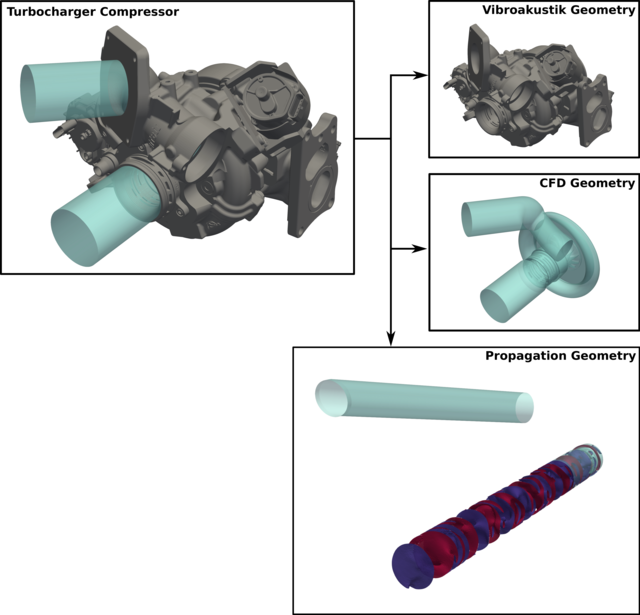Computational aeroacoustics of automotive turbocharger compressors
This project is in cooperation with BMW Steyr GmbH and Friedrich Alexander Universität Erlangen-Nürnberg, Institute of Process Machinery and Systems Engineering / Fluid System Dynamics and Flow Acoustics (www.ipat.fau.de) and is funded by the Austrian Research Promotion Agency (FFG, Nr. 867971).
An effective technology to reduce emission and fuel-consumption is the use of turbochargers. A turbocharger increases the air pressure at the inlet manifold of the engine by using the waste energy from the exhaust gas to drive a turbine wheel that is linked to the compressor through a shaft. Besides the use in combustion engines, fuel cell systems for vehicle applications also need compressed air to achieve high power densities. Thereby, in fuel cell systems the noise emission of turbochargers is no longer masked by the combustion engine. In operation, the main noise sources are generated by the flow in the compressor and the different noise phenomena need to be understood in order to efficiently reduce the emitted noise and increase comfort. A huge potential in order to achieve this goal is a simulation based investigation to study in detail the flow mechanism, the aeroacoustic sources and its sound propagation. The main goal of this research project is to develop a physical model and based on it an enhanced simulation environment, which is capable to compute the source mechanism in compressors and the sound propagation in the whole turbocharger.

Aeroacoustics of compressors is a quite new fundamental and applied research topic and strongly increases due to its practical relevance in turbomachinery. Thereby, the actual physical source mechanism as rotational and pulsation noise as well as hiss / whoosh noise is currently not fully understood. Therefore, the main goal of this research project is the physical correct modelling and numerical simulation of the aeroacoustics in compressors and the computation of the sound propagation in a whole turbocharger. In detail, the following steps will be performed. (1) instationary, compressible flow computations using LES (Large Eddy Simulation) / DES (Detached Eddy Simulation) turbulence models; (2) analysis of aeroacoustic sources computed by the pure solenoidal part of the flow velocity (vortex sound theory) applying a Helmholtz-Hodge decomposition on the compressible flow; (3) computation of the sound propagation within and outside the turbocharger based on coupled mechanical-acoustic simulations.
Publications:
- C. Freidhager, P. Maurerlehner, K. Roppert, A. Wurzinger, A. Hauser, M. Heinisch, S. Schoder, M. Kaltenbacher. "Simulationen von Strömungsakustik in rotierenden Bauteilen zur Entwicklung von Antriebskonzepten der Autos der Zukunft. Elektrotech. Inftech. (2021). https://doi.org/10.1007/s00502-021-00887-0
- Freidhager, Clemens, Stefan Schoder, and Manfred Kaltenbacher. "The influences of spatial and temporal discretization in flow simulation on Lighthill’s aeroacoustic source terms applied to a turbocharger." AIAA AVIATION 2020 FORUM. 2020. https://doi.org/10.2514/6.2020-2546
- Kaltenbacher, Manfred, Clemens Freidhager, and Stefan Schoder. "Modelling and Numerical Simulation of the Noise Generated by Automotive Turbocharger Compressor." SAE Technical Papers 2020 (2020). doi.org/10.4271/2020-01-1512
Period
- 2018 - 2021
Funding
- FFG
Members
Stefan Schoder
Tel.: +43 (0) 316 / 873 – 7763
Email
